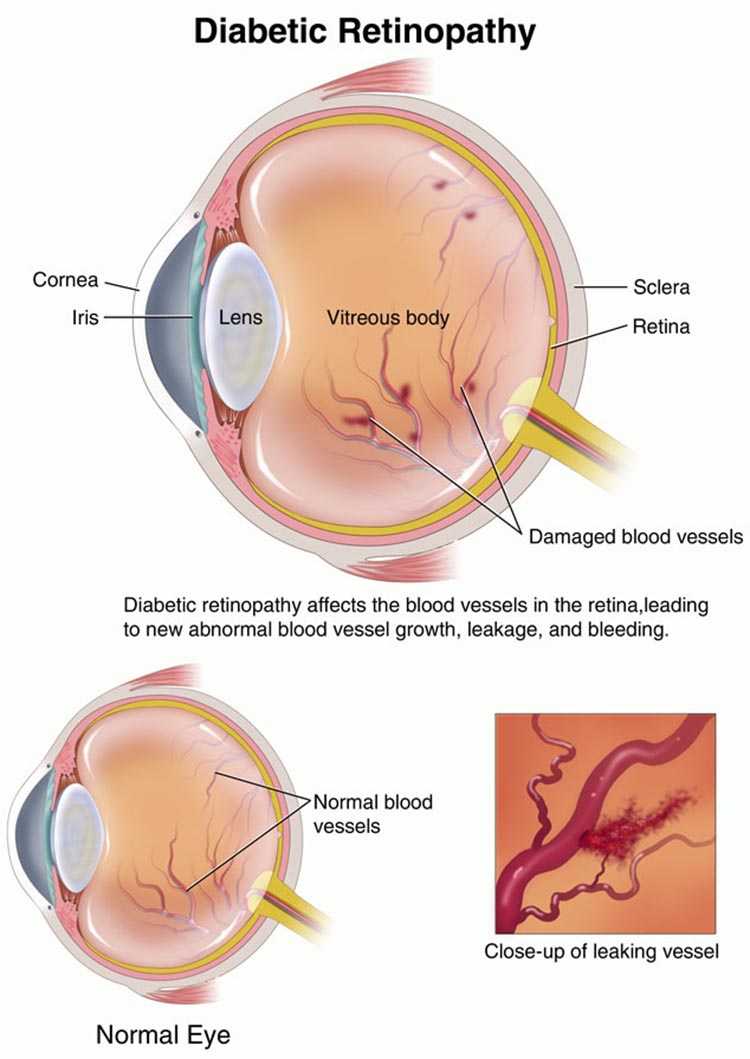Did you know diabetes is the leading cause of blindness in the United States? The disease weakens blood vessels, causing them to leak fluid into the retina. The resulting damage causes blurry, distorted vision and, in some cases, blindness.
Diabetes is the direct cause of diabetic retinopathy. Over time, diabetes will weaken blood vessels throughout the body, including the eyes. Other contributing factors like high blood pressure, pregnancy, and smoking can make diabetic retinopathy worse, so it’s extremely important to have your eyes checked regularly if you have diabetes.
Unfortunately, many patients don’t even know they have diabetic retinopathy. Usually, there is no pain or other obvious symptoms. Over time, these patients only notice slightly blurred vision and/or minimal vision loss … and even these symptoms may come and go. Only when diabetic retinopathy is severe will patients become aware of the illness. In these cases, they will notice clouded, distorted vision, or a loss of central vision. Blind spots or floaters may also appear.
To diagnose diabetic retinopathy, you first must determine if you have diabetes, and if so, what the status of your condition is. Then your vision must be tested with an eye chart, your pupils must be dilated, eye pressure tested, and with special equipment, your retinas must be examined for any obvious signs of diabetic retinopathy. Depending on your condition, you’ll receive an appropriate eye exam schedule along with a treatment plan best suited for your eyes.

It is extremely important to schedule an annual eye exam – both for yourself, and for your children. Recent studies by the Journal of Pediatrics suggest that young Type 1 and Type 2 diabetics are not getting the routine tests needed to properly manage their disease. As many as one third of those surveyed had not undergone routine eye exams or had tests of long-term blood sugar control – both of which are recommended by the American Diabetic Association.
The eye is the only organ in the body that a doctor can look through to examine blood vessels without a surgical procedure. It’s a simple, painless test that can help track and manage diabetic retinopathy, and prevent otherwise avoidable eye damage. By avoiding an annual appointment, you risk damage to your eyes that can be extremely difficult and expensive to fix. In serious cases, patients with diabetic retinopathy who have ignored symptoms and delayed treatment may require procedures like Pan-Retinal Photocoagulation or a Vitrectomy – and you can be sure, these are not nearly as easy as a routine eye exam!
Although diabetes, for the most part, cannot yet be cured, it can and should be properly managed. The first steps are though routine medical exams, including annual eye examinations. In addition, diabetic and non-diabetic patients alike should watch their diets, get regular exercise, take medications as prescribed by their doctor(s), and quit smoking! A healthy lifestyle will greatly help manage diabetes and diabetic retinopathy if you have it, and can prevent the illness altogether if you don’t.
Posted August 3, 2016 by Silverstein Eye Centers